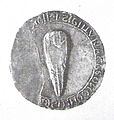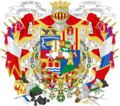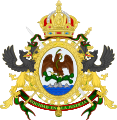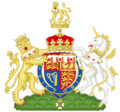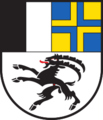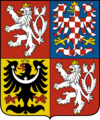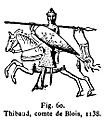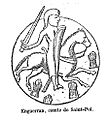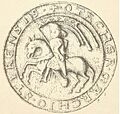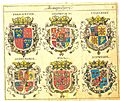History of heraldry facts for kids

Heraldry is a system of special pictures and symbols used to identify people, families, and groups. It started in Europe during the High Middle Ages, around the 12th century. It was very popular among knights, kings, and nobles. These symbols, often called "coats of arms," helped people recognize knights in battle or tournaments when their faces were hidden by helmets.
Heraldry became a full system in the 1200s and grew even more in the Late Middle Ages and Early Modern period. At first, only nobles used it. But later, wealthy common people and even churches started using their own coats of arms. Over time, the symbols of old noble families sometimes became the symbols for the towns or areas they once owned.
Western heraldry spread to other parts of the world, like Russia, Africa, and the Americas, especially during the time of exploration and colonies. Even though ideas like nobility and kings have changed, heraldry is still very much alive today. Many countries use symbols from heraldry in their national flags and emblems.
Contents
Early Symbols and Shields
Ancient Signs and Emblems
People have used symbols to identify themselves for a very long time, even back to the Bronze Age. For example, ancient armies sometimes had special signs on their shields. In ancient art, you can see animals like lions, which later became popular in heraldry.
Shields Before Heraldry
Before the 12th century, shields in Europe sometimes had simple decorations. But these designs weren't usually tied to a specific person or family. They were just decorations.
The famous Bayeux Tapestry, which shows the Norman invasion of England in 1066, displays many shields. Some are plain, while others have dragons or crosses. However, no knight is shown with the same shield design twice. Also, their descendants didn't use those same designs. This shows that these were not yet true heraldic symbols.
Early accounts of knights, like those at the court of Byzantine emperor Alexius I in the 1100s, describe shields that were shiny but had no special designs. This means that the idea of using unique symbols on shields to identify a person or family was still developing.
How Heraldry Began (12th Century)
Early Knight Seals
In the 12th century, it became popular to use "equestrian seals." These were special stamps that showed a nobleman as a fully armed knight on horseback. At first, the shields on these seals were plain. But by the mid-1100s, some seals started showing early heraldic designs. These designs were still part of the knight's equipment and sometimes hard to see clearly.
True heraldic shields, where the design was clear and important, started appearing around the very end of the 12th century or the early 13th century.
First Heraldic Designs
Some of the earliest seals with clear heraldic symbols appeared between 1135 and 1155 in England, France, Germany, Spain, and Italy. A good early example is a seal from Philip I, Count of Flanders, in 1164. By the end of the 12th century, most seals had heraldic designs.
One of the oldest knight seals with a coat of arms belongs to Henry the Lion, a duke from Germany. His seal from 1146 shows a clear lion on his shield. Another old example is the seal of Ottokar III of Styria from 1160, which shows an early version of the "panther" symbol for Styria.
The First Colored Coat of Arms
The oldest known colored picture of a coat of arms is on the tomb of Geoffrey Plantagenet, Count of Anjou, who died in 1151. A picture made around 1155-1160 shows him with a blue shield that has six golden lions on it. He also wears a blue helmet with another lion.
It's believed that Geoffrey was given this shield in 1128. His son, Henry II, and grandsons, including Richard the Lionheart, later used lions as their symbols. Richard is thought to be the first to use the three lions that are still on the Royal Arms of England today.
Crusades and Knightly Gear
The Crusades (holy wars) helped develop two important parts of heraldry:
- The Surcoat: This was a cloth garment worn over armor to protect knights from the sun. It was often decorated with the same symbols as the knight's shield. This is where the term "coat of arms" comes from!
- The Mantling: This is the flowing cloth that hangs from the helmet in modern heraldry. It started as a practical covering for the helmet and neck during the Crusades. Its torn edges, which look like fancy flourishes today, likely came from being worn out in battle or from deflecting sword blows.
Medieval Heraldry
What is a Herald?
The word "heraldry" comes from the word "herald." A herald was an officer who announced the knights at medieval tournaments. Knights wore full armor, so their shield symbols were how they were identified.
Heralds became experts in knowing the ranks, family histories, and symbols of different knights and lords. They also knew the rules for designing and describing coats of arms. By the late 1200s, some heralds working for kings were given the special title "King of Heralds," which later became "King of Arms."
The Classic Heraldic Shield
By the 1230s, shields used by knights became almost triangular, known as "heater shields." An example is the shield of Konrad von Thüringen from around 1230, which shows a "lion barry" (a lion with stripes). This heater shape became the classic heraldic shield, or "escutcheon," around the time of the Battle of Crecy (1346). By then, heraldry was a fully developed system. Most medieval lists of arms (called "rolls of arms") from the 13th to 15th centuries show this shield shape.
-
This is a "counterseal" of Alfonso II of Aragon from 1187. It's one of the earliest pictures of a "heraldic shield" by itself, showing an early version of the Pales of Aragon. At this time, the shield still had a "kite" shape.
-
This is the shield of Seedorf from the late 12th century. It's the oldest medieval shield that still exists, showing a lion standing up. It was originally a "kite shield," but the top was cut off later to look like the 13th-century "heater" shape.
-
Matthew Paris used small pictures of heraldic shields in his books around 1250 to show when kings started and ended their reigns. Here, you see the "three lions passants guardants or" (three golden lions walking with their faces turned towards you). These were used by William I and later kings like Henry I, Stephen, Henry II, John, and Henry III. In the 14th century, these became the official Royal Arms of England.
-
This picture shows the First Crusade from a manuscript dated 1287. It features Godfrey of Bouillon and Adhemar Le Puy. Godfrey has the arms of Lorraine, which is a red band with three silver birds called "alerions." Adhemar is wearing a bishop's hat and has a crescent moon on his shield.
-
This is an example of "burgher arms" (symbols for common citizens) from the end of the medieval period. Conrad Grünenberg (1487) shows his arms, which are two green hills. He also shows symbols of the "orders" (special groups) he claimed to join during his trip to Jerusalem. These include the Jerusalem cross for the Order of the Holy Sepulchre, a sword and scroll for the Order of the Sword, a vase with flowers for the Order of the Jar, and a half-wheel for Saint Catherine.
Combining Symbols
In the 13th century, coats of arms sometimes had small changes to show different family members. But they didn't often combine symbols from different families. An exception is the coat of arms of Castile and León from the late 1200s. It shows the yellow castle of Castile combined with the purple lion of León.
Combining symbols became much more common later in the medieval period. For example, the arms of Eric of Pomerania as king of the Kalmar Union (1396–1439) combined five different coats of arms. These represented Denmark, Sweden, the House of Bjelbo, Pomerania, and Norway. They were divided by a red cross with a smaller shield in the center. Later, in the 15th century, church leaders would combine their family symbols with those of their church or religious group.
Rules for Heraldry
By the mid-1300s, it was generally agreed that only one person should have the right to use a specific coat of arms. Arguments over who owned which symbols led to the creation of "heraldic authorities." These groups helped manage the use of arms. The first known book about heraldic law was written around 1350 by Bartolus de Saxoferrato.
A famous dispute in English heraldry was the "Scrope v Grosvenor" case in 1390. Two different men claimed the right to use the same blue shield with a gold bend (a diagonal stripe). Because so many people were using the same symbols, King Henry V made a rule in 1419. He said that only those who had used arms at the Battle of Agincourt could keep them, unless they inherited them or were given them by the king.
Heraldry in Later Times
Heraldic Organizations
In 1484, during the reign of King Richard III, the heralds working for the king formed the College of Arms. This group would be in charge of giving out all new coats of arms. Today, the college has three "Kings of Arms" and other officers, all working under the authority of the king or queen. Other countries also have similar groups that manage heraldry. However, in many places, there are no laws stopping people from using any arms they like, as long as they don't copy someone else's.
From the 1530s to 1700, the Kings of Arms would travel around the country on "heraldic visitations." They would record who was using arms correctly. If someone was using arms without permission, they had to get permission or stop using them.
Different Styles of Heraldry
During the early modern period, heraldry became very detailed and organized. It developed into different "national" styles. Western heraldry can be divided into three main groups:
- Gallo-British: This includes French, English, and Scottish heraldry.
- German-Nordic: This group covers the Holy Roman Empire and nearby areas, like Germany, Sweden, Norway, Denmark, Russia, Poland, and Hungary.
- Latin: This includes Italian, Spanish, and Portuguese heraldry.
Dutch heraldry has influences from all three groups.
Wealthy citizens and even cities started to use or be granted coats of arms. These symbols were used in many ways, like in religious art, on tombstones, carved wood, stained glass, and embroidery.
After the 1600s, when jousting (knightly fighting games) became less common, the helmets in heraldry stopped being tied to real armor. They became more like traditional symbols, and different helmet shapes came to represent different ranks of nobility.
Later, in the 1700s and 1800s, heraldic designs became very fancy and complex. Some even included realistic pictures of landscapes.
Heraldry Today
Modern Uses
In the mid-1800s, people became very interested in the history of heraldry. They started to appreciate the older, medieval designs more than the very fancy ones from later periods. Since the late 1800s, heraldry has focused on creating new and unique designs using different patterns and symbols.
The term "heraldry" is sometimes used to include the national symbols of modern countries. Some countries that are republics (not monarchies) might use "national seals" or "national emblems" instead of traditional coats of arms. However, many countries, both monarchies and republics, still use national coats of arms. Examples include Denmark, Spain, Finland, Iceland, Portugal, and the United States.
-
This 19th-century German heraldry example shows the arms of Saxe-Altenburg with seven crests (symbols on top of the helmet). Some old coins even showed as many as fifteen crests!
-
This is a complex example of 19th-century Spanish heraldry: the Coat of arms of Baldomero Espartero, Prince of Vergara (1793–1879).
-
This is the Coat of arms of the Kingdom of Prussia from 1873.
-
This is the Coat of arms of the Mexican Empire from 1864.
-
This is the Coat of arms of Prince Harry, Duke of Sussex (born 1984), which was granted to him in September 2002 on his 18th birthday.
-
This is the modern coat of arms of the Swiss canton of Graubünden. It was created in 1932 by combining three older coats of arms from the 15th and 16th centuries.
Images for kids
-
These are early shield decorations shown in the Bayeux Tapestry (around 1077). They are "proto-heraldic," meaning they came before true heraldry.
-
This is the equestrian seal of Ottokar III of Styria, from 1160. It shows an early form of the Styrian panther on his shield.
-
This is an enamel from the tomb of Geoffrey Plantagenet, Count of Anjou. It shows his shield from the side, with four of what were probably six lions visible. His grandson, William Longespée (died 1226), had six lions on his shield.
-
This picture shows emperor Frederick Barbarossa as a Crusader (around 1188). The cross symbol on his shield and surcoat at this time was not a personal symbol. It was a sign worn by all participants in the Crusade.
-
This is a "counterseal" of Alfonso II of Aragon from 1187. It's one of the earliest pictures of a "heraldic shield" by itself, showing an early version of the Pales of Aragon. At this time, the shield still had a "kite" shape.
-
This is the shield of Seedorf from the late 12th century. It's the oldest medieval shield that still exists, showing a lion standing up. It was originally a "kite shield," but the top was cut off later to look like the 13th-century "heater" shape.
-
Matthew Paris used small pictures of heraldic shields in his books around 1250 to show when kings started and ended their reigns. Here, you see the "three lions passants guardants or" (three golden lions walking with their faces turned towards you). These were used by William I and later kings like Henry I, Stephen, Henry II, John, and Henry III. In the 14th century, these became the official Royal Arms of England.
-
This picture shows the First Crusade from a manuscript dated 1287. It features Godfrey of Bouillon and Adhemar Le Puy. Godfrey has the arms of Lorraine, which is a red band with three silver birds called "alerions." Adhemar is wearing a bishop's hat and has a crescent moon on his shield.
-
This is an example of "burgher arms" (symbols for common citizens) from the end of the medieval period. Conrad Grünenberg (1487) shows his arms, which are two green hills. He also shows symbols of the "orders" (special groups) he claimed to join during his trip to Jerusalem. These include the Jerusalem cross for the Order of the Holy Sepulchre, a sword and scroll for the Order of the Sword, a vase with flowers for the Order of the Jar, and a half-wheel for Saint Catherine.
-
This is the "Quaternion eagle", which represents the different parts of the Holy Roman Empire (1510).
-
These are the Arms of Charles V, Holy Roman Emperor in the choir of the Cathedral of Cordoba, from the 16th century.
-
This 19th-century German heraldry example shows the arms of Saxe-Altenburg with seven crests (symbols on top of the helmet). Some old coins even showed as many as fifteen crests!
-
This is a complex example of 19th-century Spanish heraldry: the Coat of arms of Baldomero Espartero, Prince of Vergara (1793–1879).
-
This is the Coat of arms of the Kingdom of Prussia from 1873.
-
This is the Coat of arms of the Mexican Empire from 1864.
-
This is the Coat of arms of Prince Harry, Duke of Sussex (born 1984), which was granted to him in September 2002 on his 18th birthday.
-
This is the modern coat of arms of the Swiss canton of Graubünden. It was created in 1932 by combining three older coats of arms from the 15th and 16th centuries.
See also
- Ordinary of arms
- Military colours, standards and guidons
- Vexillology
- Naval heraldry


